  |
|
|
|
|
|
|
  |
|
|
|
|
|
|
Directory of Paintguns
Page 3 - Phantom to Spyder
Go to Index Page Number 1 2 3 4 5
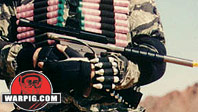 |
One of the only paintguns to remain in production from the mid 1980s (1987) into the new millennium while maintaining the same basic design. The Phantom represents what became of paintguns based on the Nelson valve design in the mid to late 80 - sleek bore drop pump action paintguns. As one of the only remaining production paintguns available in a true stock class configuration, the Phantom remains a market leader for this specialty group. |
||
| The Phantom FAQ by Rob Griffin |
|||
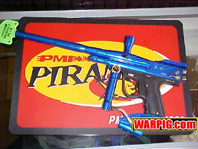 |
From the late 90s and into the new millennium, the stacked tube blowback layout was common to many paintgun designs. The Piranha's distinguishing feature found in its first, as well as later models, was a thumb lever to trip and hold the sear, making it easier field strip and reinsert the bolt and hammer without removing the grip frame. From the first mechanical triggered models on up to more advanced electromechanical models with solenoid grip frames, the Piranha has been a mainstay for manufacturer/distributor PMI. |
||
| A First Look at the Piranha by CJ Schaff |
|||
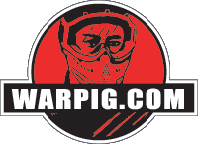 |
The workhorse semis of the early 1990s. Tippmann's Pro-Am, Pro-Lite and Carbine were known for being nearly industructable and being backed by quality customer service. |
||
| Tippmann Pro-Am FAQ by Steve Mitchell Inside the Tippmann - how these paintguns work Tippmann Pro-Lite FAQ by Justin "Zorko" Grill Tippmann Carbine FAQ |
|||
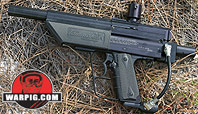 |
The Rainmaker was Brass Eagle's first step into manufacturing an electropneumatic paintgun. In operation the Rainmaker was based on the design of the Air Power Vector, and designed by the same airsmith. In comparison to the Vector, the Rainmaker used fully interchangeable parts (Vector valve components had to be custom machined to fit each paintgun) and more modular structure, as well as the addition of electropneumatic control. |
||
| Rainmaker FAQ Rainmaker Owner's Group |
|||
 |
While based on the Ion's technology, the SP-8 is built and intended for the recreational and scenario paintball market, rather than the concept field tournament player. Not only is the look different from what speedball players are used to, but the performance is not what scenario and woods players are used to. The XP-8 is the first mass produced electropneumatic paintgun built specifically for the woods/scenario paintball, bringing an electronic trigger, and the functionality of multiple modes of fire and anti-chop eyes with it. The SP-8's exterior mimics the shape and feel of an XM-8 Battle Rifle, a prototype assault rifle designed by German arms manufacturer Heckler & Koch as a replacement for the US Military's M-16 design. |
||
| WARPIG.com SP-8 review SP-8 Adjustable Stock Stealth Barrel and Tactical Rails Smart Parts' Firebolt and 360 QEV Timing Guide with Dwell/ROF Calculator APE Rampage Board YDNA's Electronics Guide for the Ion applies to the SP-8 as well |
|||
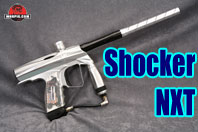 |
Smart Parts Shocker NXT is a refinement of the Shocker SFT. Many of the parts are compatible. It features a break-beam eye system, and the Shocker HE bolt/valve system, as well as a higher-flow rate regulator based on the Ion regulator design. |
||
| Shocker NXT review 40 Minute Tech-Tour Video A look at rebound Shocker Owners Group Ydna's Shocker NXT Resources |
|||
 |
From low pressure, big, and heavy to, low pressure, small, light and fast, Smart Parts has totally redesigned the Shocker. |
||
| Shocker SFT Review HE Bolt Kit - Smart Parts' High Efficiency bolt and valve upgrade A Look At Rebound - understanding the Rebound Mode in the Shocker SFT and Nerve Virtue Board from Advantage PB for the Shocker SFT and Nerve Shocker Air Vent Manifold Critical Impact Shocker Trigger Custom Products Shocker Trigger Shocker Owner's Group Shocker SFT FAQs by Ydna Shocker SFT Tips by Ydna Shocker SFT Dwell, Circuit Board and Solenoid Guide by Ydna Shocker SFT Troubleshooting Guide by Ydna Shocker SFT Maintenance Guide by Ydna |
|||
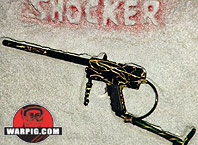 |
The PVI Shocker built by PneuVentures and distributed by Smart Parts and introduced to the US market an 1997, as well as its successor models - Shocker Sport and Turbo - were known for quiet operation and accuracy. With a low operating pressure these designs used dual solenoid valves, one to operate the bolt with its integrated ram, and the other to operate a shuttle valve to fire the paintball. Their size, shape and weight earned these early generation Shockers the nicknames of Shoebox and Brick. |
||
| Old School Shocker FAQ by Pal McClung Inside Turbo Mode - a look at the controversial rate of fire ramping mode Shocker Sport FAQ by ydna Shocker Sport Maintenance Guide by ydna Shocker Sport Troubleshooting guide by ydna PVI Shocker info by ydna |
|||
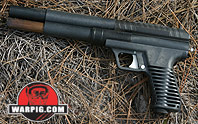 |
The sidekick semi was produced by Dave's Scent Delivery System (a manufacturer of .68 cal scent delivery pistols for hunters) and distributed to the paintball market by PaintballStuff.com. While it bore a physical resemblance to the DSD9 pump action pistol, its internals and operation were completely different. It utilized a blow forward bolt similar to an Automag and Desert Fox. A spring loaded sear more similar to that of the Foxes captured the bolt and held it back. Like the later model Desert Foxes, the Sidekick Semi had no on/off valve, it simply relied on restricted gas flow to its air chamber to allow the bolt to reset. An inline spring fed magazine fed paintballs to the chamber. |
||
| Sidekick Semi review |
|||
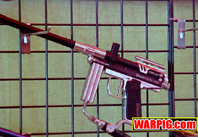 |
Kingman changed the face of low to mid cost semi-auto paintguns when they took advantage of high volume overseas manufacturing to bring an affordable all metal construction semi-auto paintgun to the US market in the mid 1990s. In the following years they have evolved the design of the Spyder maintaining the core stacked tube blowback layout but adding features such as anti-chop bolts and electromechanical trigger frames. |
||
| The original Spyder FAQ by CJ Schaff Jeff Shult'z basic Spyder trigger job Nursing a sick Spyder back to health by Dave Read |
|||
| Copyright © 1992-2019
Corinthian Media Services. WARPIG's webmasters can be reached through our feedback form. All articles and images are copyrighted and may not be redistributed without the written permission of their original creators and Corinthian Media Services. The WARPIG paintball page is a collection of information and pointers to sources from around the internet and other locations. As such, Corinthian Media Services makes no claims to the trustworthiness or reliability of said information. The information contained in, and referenced by WARPIG, should not be used as a substitute for safety information from trained professionals in the paintball industry. |